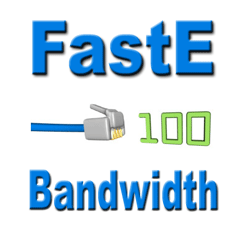Businesses that need more bandwidth than their T1 lines can provide have usually upgraded to DS3. However, a faster and more affordable option, Fast Ethernet (FastE), is now available.
 While you might not know Fast Ethernet as a Metro or Carrier bandwidth service, the term is likely familiar. Fast Ethernet refers to 100 Mbps Ethernet, one of the standard LAN speeds alongside 10 Mbps and 1,000 Mbps Ethernet (Gigabit Ethernet or GigE). The next level up is 10 Gigabit Ethernet (10 GigE).
While you might not know Fast Ethernet as a Metro or Carrier bandwidth service, the term is likely familiar. Fast Ethernet refers to 100 Mbps Ethernet, one of the standard LAN speeds alongside 10 Mbps and 1,000 Mbps Ethernet (Gigabit Ethernet or GigE). The next level up is 10 Gigabit Ethernet (10 GigE).
Most network devices, such as PCs, printers, Ethernet switches, routers, and servers, have Network Interface Cards (NICs) that support Fast Ethernet. Many smaller business LANs already operate at the Fast Ethernet speed of 100 Mbps. So why do WAN connections often use slower speeds?
Cost is a significant factor. WAN network services are generally considered expensive because they are leased lines with recurring monthly charges. In contrast, LAN networks have an upfront cost for purchase and installation, with minimal maintenance required afterward for smaller networks.
Another reason for lower bandwidth on WANs compared to LANs is usage patterns. Most internal company network traffic stays on the LAN, primarily between PCs and servers or for file transfers between offices. Traffic leaving the building is typically for internet access, including websites and email. Companies with multiple locations often use dedicated lines or MPLS networks to connect them, resulting in higher traffic on those links as they act as internal LAN connections.
Several factors are changing this situation. WAN bandwidth demands are increasing due to larger file sizes and the growing use of video in business. However, the most significant impact comes from the shift from in-house IT services to hosted and cloud-based services. This shift pushes most traffic from LAN to WAN, requiring increased line speeds to handle the higher traffic volume and avoid slowdowns that can reduce productivity.
Medium and large companies outgrew their T1 lines long ago and upgraded to T3 service, commonly known as DS3. DS3 provides 45 Mbps of bandwidth, significantly higher than T1’s 1.5 Mbps, but at a much higher monthly cost, often reaching thousands of dollars.
DS3 has been crucial for bandwidth-intensive applications like video streaming, e-commerce, large office internet access, and medical image transmissions. As a readily available digital telecom service, its cost has decreased over time. So why consider alternatives to DS3?
Cost and bandwidth are the driving factors. Fast Ethernet, at 100 Mbps, offers over twice the bandwidth of DS3’s 45 Mbps without a proportional increase in cost. FastE might even cost the same or less than your existing DS3 connection. Considering that Fast Ethernet closely aligns with LAN protocols and both DS3 and FastE utilize fiber optic lines, sticking with DS3 might not be the most practical choice.
However, DS3 might still be suitable if Carrier Ethernet services are not yet available in your area. Despite this, competitive carriers are expanding their metro fiber networks, offering lower bandwidth prices to attract business customers.
If you use DS3 and want to maximize your bandwidth budget or require new high-speed line installations, explore the pricing and availability of Fast Ethernet vs. DS3. Evaluating the competitive options allows you to determine the most suitable service type and level for your business needs.

